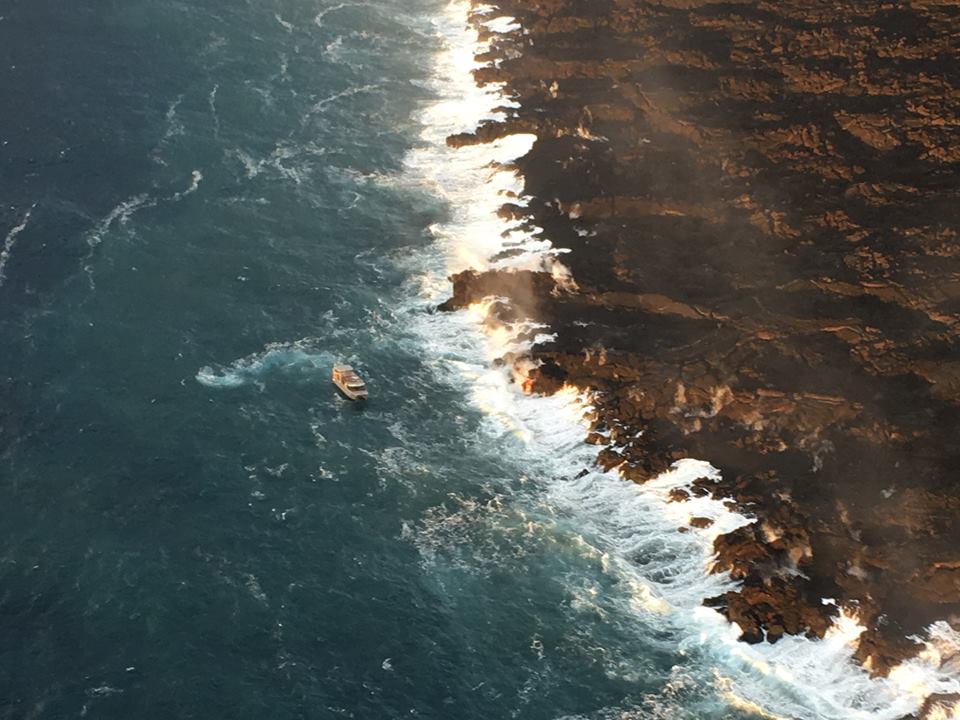
Weekly Eruption Summary
After a busy few months, Kilauea continues to rest with only a pilot light on, so to speak. This week’s big news was that Hurricane Lane passed offshore of the Big Island on Thursday through Saturday, causing extensive flash flooding. But there’s still a little news to report on the dying (?) embers of Kilauea’s 2018 eruption.
On Friday morning, the Hawaii County Fire Department observed a small lava pond still visible deep in Fissure 8’s cone. For most of the week, there was no visible activity apart from a few small jets deep in the cone throwing weak spatter on Monday morning:

The sputtery jets proved to be temporary:

Down at the ocean at Kapoho, there were a few weak dribbles of lava continuing to drain out of the delta at the beginning of the week:

Sulfur dioxide emissions continue to be very low both at the summit and the coast. In fact, on Tuesday, they dropped too low in the Lower East Rift Zone for instruments to measure, although not too low for highly-sensitive human noses to detect.
Video from August 17 posted on the 20th— full-sized version here.
USGS' UAS team takes you inside the fissure 8 cinder cone, on Kīlauea's lower East Rift Zone. Seismicity and ground deformation are negligible at both the summit and #LERZ; the lull continues. https://t.co/FtgY4MISEU pic.twitter.com/Oud0nsOcH3
— USGS Volcanoes🌋 (@USGSVolcanoes) August 21, 2018
Heavy rain from Hurricane Lane on Friday and Saturday put a hold on USGS overflights and field observations and knocked out a few sensors on the east side of the island. But Kilauea’s extensive sensor network means there was no gap in volcano monitoring, and field crews were on call just in case.
The hurricane had no impact on the volcano apart from heavy rainfall hitting hot rocks and turning to steam in Pu’u O’o’s crater and on the not-yet-cooled lava flows of the LERZ. There were some reports of local white-out conditions from this steam. Rain may also have triggered a few rockfalls at the summit.
The other big Kilauea news this week is that Hawaii Volcanoes National Park has set a target reopening date for September 22, aiming to reopen at least the Visitor Center and (they hope) some kind of viewing area from which visitors will be able to see the new, larger Halema’uma’u Crater. They’re also hoping to open Volcano House, but they need to check the stability of the cliffs on which it stands.
National Park Service Geomorphologist Eric Bilderback began evaluating earthquake damage today. All work on recovery will pause this afternoon in preparation for Hurricane Lane. The entire park is closed today and tomorrow. Stay up to date: https://t.co/9Q4rYdxOd2 pic.twitter.com/9uSNWxTpwb
— Hawaii Volcanoes NPS (@Volcanoes_NPS) August 22, 2018
USGS Volcano Watch
Whoops! I think I missed last week’s edition. This is Hawaiian Volcano Observatory’s weekly column with photos and in-depth information on some aspect of Kilauea.
- August 16: “Submarine Kilauea also impacted by recent events at the volcano” with a report on earthquake sensors deployed on seabed in July.
- August 23: “Voggy skies from days gone by: Reviewing Kilauea Volcano’s gas release” Lots of numbers, but they’re of critical importance to those who have to breath the stuff. This article is a overview of the rise and fall of SO2 levels (vog) from the beginning of the Pu’u O’o eruption in 1983 up to the present lull in eruptive activity.
Continue reading August 27: After Fire, Flood (Hurricane Lane)
